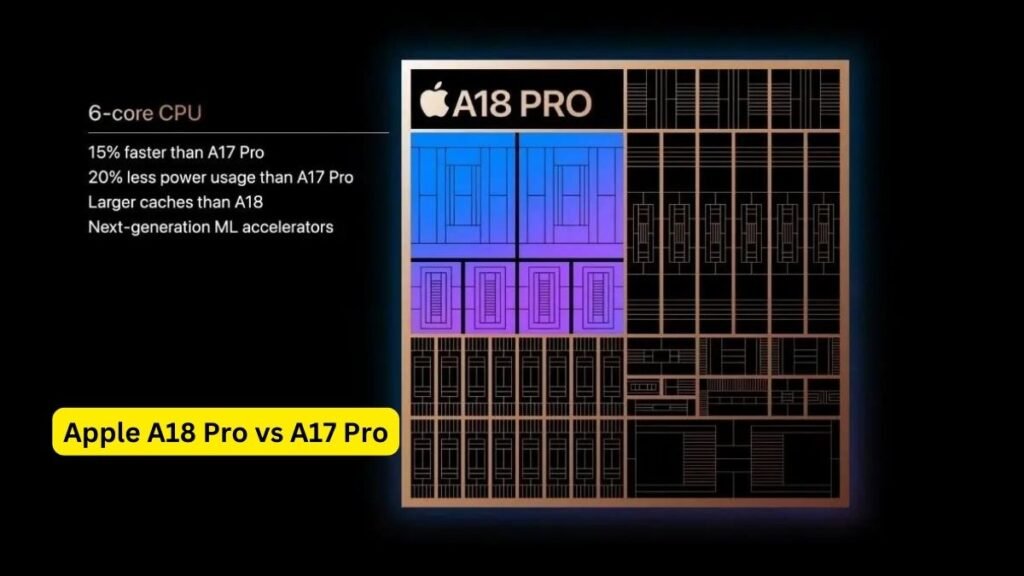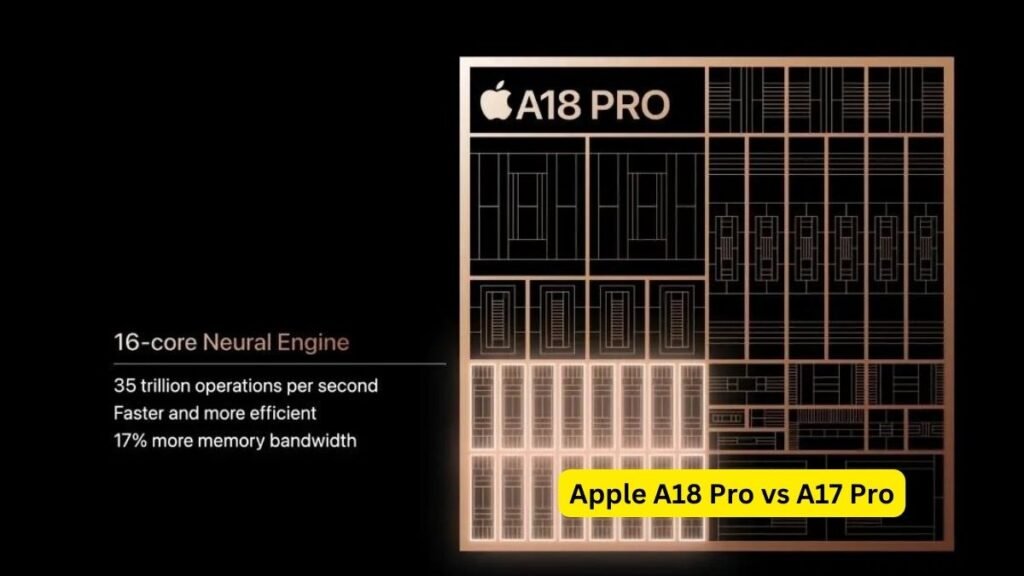Apple’s new iPhone models often bring with them advancements in chipset technology, and the Apple A18 Pro and A17 Pro are no exception. These two chipsets are at the heart of Apple’s most recent mobile devices, but they differ in several key aspects. In this in-depth comparison, we will analyze the technical specifications, performance benchmarks, power efficiency, and unique features of both the A18 Pro and A17 Pro. This article aims to provide you with a clear understanding of which chipset offers better performance and whether the upgrade from the A17 Pro to the A18 Pro is worth it.
Apple A18 Pro vs A17 Pro: Key Specifications
When comparing Apple’s A18 Pro and A17 Pro, it’s crucial to first look at the technical specifications. The A18 Pro represents a more recent iteration of Apple’s Bionic chipsets and introduces enhancements across CPU, GPU, and neural engine performance.
A18 Pro Specifications
- Manufacturing Process: 3nm (Nanometer)
- CPU Cores: 6-core (2 performance cores + 4 efficiency cores)
- GPU Cores: 5-core GPU
- Neural Engine: 16-core Neural Engine
- RAM Support: LPDDR5X (up to 8GB)
- AI Performance: 40% improved performance over A17 Pro
- Camera Processing: Enhanced computational photography
A17 Pro Specifications
- Manufacturing Process: 5nm (Nanometer)
- CPU Cores: 6-core (2 performance cores + 4 efficiency cores)
- GPU Cores: 5-core GPU
- Neural Engine: 16-core Neural Engine
- RAM Support: LPDDR5 (up to 6GB)
- AI Performance: 20% faster than A16 Bionic
- Camera Processing: Standard computational photography improvements
Performance Improvements with A18 Pro
One of the most noticeable differences between the A18 Pro and A17 Pro is in performance benchmarks. Apple’s move to the 3nm manufacturing process in the A18 Pro chipset results in enhanced efficiency and faster processing speeds.
CPU Performance

The A18 Pro utilizes a 3nm manufacturing process, which is a significant leap from the 5nm process of the A17 Pro. This new process allows the A18 Pro to pack more transistors into the same space, improving both efficiency and raw power. As a result, the A18 Pro offers a 20% improvement in CPU performance over the A17 Pro. This means that applications requiring high processing power, such as video editing or gaming, will run smoother and faster on devices with the A18 Pro chipset.
In comparison, the A17 Pro—while still a powerful chipset—is marginally slower in handling multi-core tasks. The A18 Pro excels in multi-threaded workloads, making it the better option for professionals or users who frequently perform heavy multitasking.
GPU Upgrades

Both the A17 Pro and A18 Pro feature a 5-core GPU, but the A18 Pro benefits from significant architectural improvements. These improvements result in 30% faster graphical performance, making the A18 Pro more capable of handling graphic-intensive tasks such as gaming, 3D rendering, and augmented reality (AR) applications.
For users who prioritize gaming or multimedia editing, the A18 Pro provides an overall smoother experience with fewer lags and improved frame rates. Although the A17 Pro’s GPU performance is impressive in its own right, the A18 Pro clearly outpaces it in next-generation gaming and AR capabilities.
Power Efficiency and Battery Life
The power efficiency of a chipset plays a critical role in battery life. Apple has always prioritized energy efficiency, and the A18 Pro makes further strides in this area compared to the A17 Pro. Thanks to the 3nm process, the A18 Pro consumes 25% less power than the A17 Pro under similar workloads.
This efficiency gain is particularly evident in tasks that demand prolonged usage, such as video streaming, browsing, and gaming. Users can expect a noticeable improvement in battery life, with devices powered by the A18 Pro lasting several hours longer on a single charge compared to A17 Pro-powered devices.
The A17 Pro, while efficient in its own right, does not match the power-saving capabilities of the A18 Pro, especially during high-performance tasks.
AI and Machine Learning Capabilities

Both the A18 Pro and A17 Pro come equipped with a 16-core Neural Engine, but the A18 Pro has additional optimizations that enhance its AI and machine learning performance. Apple claims that the A18 Pro delivers 40% faster machine learning tasks than its predecessor. This increase in performance significantly benefits tasks like image recognition, natural language processing, and real-time translation.
The A17 Pro also performs well in AI-driven applications, but the A18 Pro’s enhanced machine learning capabilities give it an edge, especially in future-proofing devices for next-generation AI features.
Camera and Computational Photography
Apple’s chipsets are integral to the company’s renowned camera performance. The A18 Pro features enhancements in computational photography, making it better suited for low-light photography, portrait modes, and video processing.
The A18 Pro also introduces more advanced image signal processing (ISP), allowing for richer color accuracy, better dynamic range, and more detailed photos. This is a critical upgrade for users who prioritize camera quality on their devices.
While the A17 Pro also supports high-quality computational photography, the A18 Pro’s upgrades in image processing make it superior in capturing sharper photos and smoother videos.
Final Verdict: Is the A18 Pro Worth the Upgrade?
The Apple A18 Pro chipset introduces several significant improvements over the A17 Pro, particularly in the areas of performance, power efficiency, AI capabilities, and camera enhancements. For users who require the fastest performance, longer battery life, and the latest advancements in computational photography, the A18 Pro is a clear choice. It’s an ideal upgrade for power users, gamers, and those looking to future-proof their devices.
However, if you are satisfied with the A17 Pro’s solid performance and don’t need the cutting-edge features of the A18 Pro, the A17 Pro remains a highly capable chipset that will serve most users well.
In conclusion, the A18 Pro delivers on Apple’s promise of better performance and efficiency, making it the best choice for users who demand the highest level of mobile computing power.
In this blog, we have provided detailed information on Apple A18 Pro vs A17 Pro. We appreciate you taking the time to read this post about Apple A18 Pro vs A17 Pro in our blog! If you find this information useful, please share this blog with your friends and family so that they can also know about Apple A18 Pro vs A17 Pro. Visit our website homepage weblog365.in to read more interesting and informative blogs and stay updated.

My name is Yogesh Pandey, and I hail from Lucknow, India. I work in digital marketing. I have been blogging since 2023. I write about Technology, Entertainment, Automobile, and Lifestyle providing insights to help others find quality products. I am excited to have the opportunity to collaborate with weblog365.in now. You can reach out to me via email at weblog365.in@gmail.com. Let’s connect! 🙏

